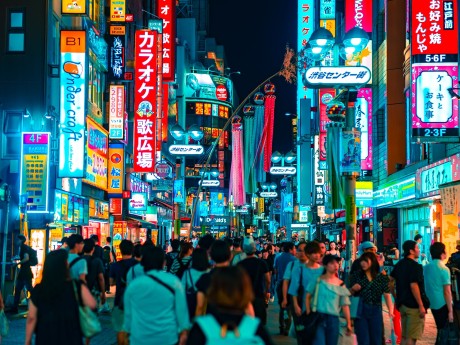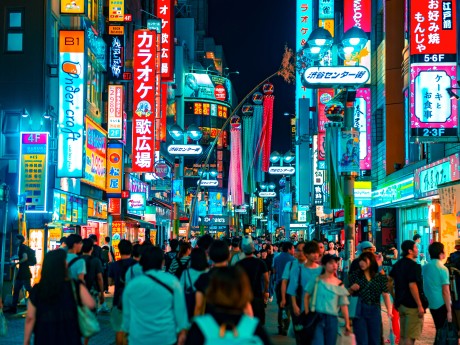Japan: Tokyo
Embark on an unforgettable journey through the bustling streets of Tokyo, where ancient traditions harmonize with cutting-edge innovation to create a captivating tapestry of culture, cuisine, and endless adventure. Witness the iconic Shibuya Crossing, a symbol of Tokyo's vibrant urban life or see panoramic views of the city from the Tokyo Skytree. Culinary delights await at every turn in Tokyo's bustling streets and hidden alleyways.
Read more
Embark on an unforgettable journey through the bustling streets of Tokyo, where ancient traditions harmonize with cutting-edge innovation to create a captivating tapestry of culture, cuisine, and endless adventure. Witness the iconic Shibuya Crossing, a symbol of Tokyo's vibrant urban life or see panoramic views of the city from the Tokyo Skytree. Culinary delights await at every turn in Tokyo's bustling streets and hidden alleyways. Indulge in a sensory journey through Tsukiji Outer Market, sampling fresh sushi and savouring street food delicacies. Explore the various temples such as Senso-ji Temple and shrines like the Meiji Shrine around the city to be amazed by the structures. Discover the magic at Tokyo Disneyland or Tokyo DisneySea. This trip has something for everyone and will leave you feeling amazed! Waterviews strives to offer accommodation options within walking distance of water and/or in an area of touristic interest. Our prices include taxes (but excludes local tourist taxes). Customize your trip to your personal preferences with optional activities (hit the “Add Activities’’) or change hotels, etc. Contact us for customization at no extra cost at: Service@waterviewstravel.com
Destinations
- Tokyo
Itinerary
Tokyo

Often referred to as the world’s largest city, Tokyo is Japan’s fascinating and dynamic capital and offers a perfect blend of the country’s modernity and rich traditions. Backed by the snow-capped peak of Mount Fuji, the city is bursting with culture, and its world-renowned culinary scene only adds to the appeal. From its futuristic skyscrapers and neon lights to its picturesque cherry blossoms and peaceful shrines, Tokyo truly offers something for everyone.
Read more
Often referred to as the world’s largest city, Tokyo is Japan’s fascinating and dynamic capital and offers a perfect blend of the country’s modernity and rich traditions. Backed by the snow-capped peak of Mount Fuji, the city is bursting with culture, and its world-renowned culinary scene only adds to the appeal. From its futuristic skyscrapers and neon lights to its picturesque cherry blossoms and peaceful shrines, Tokyo truly offers something for everyone.
Additional Information
Over 500 years old, the city of Tokyo was once the modest fishing village of Edo (江戸 - literally Gate of the River) due to its location at the mouth of Sumida-gawa. The city only truly began to grow when it became the seat of the Tokugawa shogunate in 1603, who decided to set up a new seat of power far away from the intrigues of the imperial court in Kyoto. After the Meiji restoration in 1868, during which the Tokugawa family lost its influence, the emperor and the imperial family moved here from Kyoto, and the city was renamed to its current name, Tokyo, literally the "Eastern Capital". The metropolitan center of the country, Tokyo is the destination for business, education, modern culture, and government. (That's not to say that rivals such as Osaka won't dispute those claims.)
Culture
Tokyo is vast: it's best thought of not as a single city, but a constellation of cities that have grown together. Tokyo's districts vary wildly by character, from the electronic blare of Akihabara to the Imperial gardens and shrines of Chiyoda, from the hyperactive youth culture mecca of Shibuya to the pottery shops and temple markets of Asakusa. If you don't like what you see, hop on the train and head to the next station, and you will find something entirely different.
The sheer size and frenetic pace of Tokyo can intimidate the first-time visitor. Much of the city is a jungle of concrete and wires, with a mass of neon and blaring loudspeakers. At rush hour, crowds jostle in packed trains and masses of humanity sweep through enormous and bewilderingly complex stations. Don't get too hung up on ticking tourist sights off your list: for most visitors, the biggest part of the Tokyo experience is just wandering around at random and absorbing the vibe, poking your head into shops selling weird and wonderful things, sampling restaurants where you can't recognize a single thing on the menu (or on your plate), and finding unexpected oases of calm in the tranquil grounds of a neighbourhood Shinto shrine. It's all perfectly safe, and the locals will go to sometimes extraordinary lengths to help you if you just ask.
Expenses
The cost of living in Tokyo is not as astronomical as it once was. Deflation and market pressures have helped to make costs in Tokyo comparable to most other large cities in the developed world. Visitors from San Francisco, Los Angeles, New York, Chicago, London, Paris, Sydney, Toronto and Dublin will not find it any more expensive than back home. Travellers should budget a similar amount of money for their stay in Tokyo as they would for any other great city in Europe, North America or Australia. Locals will know the bargains, but experienced cheapskates from anywhere in the world can get by with a little ingenuity. Tokyo is one of the most popular places to live in Japan. Rent for a single's apartment could range from USD500 to USD1,000 a month. Tokyo is so overwhelmingly crowded that many people live in apartments no bigger than 16 square meters (175 square feet).
Climate
<ref name# JMA1> }}
Tokyo is classified as lying in the humid subtropical climate zone and has five distinct seasons. Spring kicks off with plum blossoms in late February, followed by the famous cherry blossoms (sakura) in March–April. Parks, most famously Ueno, fill up with blue tarps and sozzled salarymen. Rainy season (baiu or tsuyu) in late May to June means a month of overcast skies and drizzle punctuated with downpours, with temperatures in the twenties. Summer really kicks off in July, with clear skies but temperatures peaking into the high thirties and brutal steam bath humidity. Even a short walk outside will leave you drenched in sweat, so this is probably the worst time of year to visit, and is best avoided if you have a choice. The one bright spot is the plethora of fireworks, most notably the epic pyrotechnic extravaganza of the Sumidagawa Fireworks Festival on the fourth Saturday in July. Fall from September onwards means cooler temperatures and fall colors. While southern Japan is regularly battered by typhoons this time of year, they mostly (but not always) veer clear of Tokyo. Winter is usually mild, with temperatures generally ranging from 0-10 °C, though occasional cold spells can send temperatures plummeting below zero at night, and indoor heating can leave much to be desired. Snow is rare, but on those rare occasions once every few years when Tokyo is hit by a snowstorm, much of the train network grinds to a halt.
© Sourced from Wikivoyage





